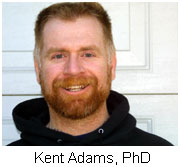









|
Ken Beilman the Author:


"Sarcopenia, Aging, and Resistance Training"
"The goal of life is to die young, as late as possible." - Ashley
Montague
Background
The U.S. population is getting dramatically older. Around 2011 the
"baby-boom" generation will turn 65, and by 2030 the number of elderly
adults will double, with 1 out of every 5 adults over 65 years old.
Currently, the "oldest-old" (those over 85 years) number about 5
million, with estimates on growth of the oldest-old over the next 30
years ranging from 8 to 24 million. With these dramatic demographic
changes, it is important for the physician to understand sarcopenia and
its relation to quality of life.
Sarcopenia
Sarcopenia, or the age-related loss of muscle mass, is derived from the
Greek word roots sarx for flesh and penia for loss.
Sarcopenia is significantly related to age-related decreases in muscle
performance (e.g., strength, power, and endurance). Despite the lack of
a direct link to death, sarcopenia, more than any other single factor,
is responsible for the frailty and diminished vitality we associate with
old age. Loss of muscle performance leads to declining activity,
increasing frailty and functional dependence - a vicious cycle which
often leads to nursing home admission. Further consequences include gait
and balance problems, falls and fractures, and an increased risk of
chronic diseases such as osteoporosis and diabetes.
Sarcopenia is commonly seen with advanced age, but that does not mean
that sarcopenia is a completely normal part of the aging process.
Besides normal physiological aging (e.g., selective loss of muscle
fibers) and the accumulation of chronic diseases and medications,
chronic sedentariness, an epidemic in our modern society, is a
significant contributor to this condition. In essence, inactivity mimics
aging, and can be likened to bed rest or space flight, which has
negative effects on all systems of the body, including preservation of
lean muscle mass. Recent reports from the Center for Disease Control and
Prevention indicate that only 15% of adults perform the recommended
amount of physical activity, with even less participating in any form of
resistance training, crucial to the prevention of sarcopenia.
Sarcopenia and Resistance Training
Resistance (strength) training is typically defined as exercise training
in which the resistance against which a muscle generates force is
progressively increased over time. Studies have consistently shown that
if the basic requirements of intensity and duration are met, older
adults show similar gains in muscle performance compared with younger
individuals as a result of resistance training. Research strongly
suggests that due to the positive functional outcomes, no segment of the
population's quality of life can benefit more from resistance training
than the elderly.
Lean Body Mass and Function
Muscle mass declines with age, with a preferential atrophy and loss of
Type II, fast-twitch fibers. Muscle performance is strongly related to
muscle size. Therefore, this age-related loss of muscle mass (sarcopenia)
has dire consequences in daily function requiring strength, power, and
endurance. In fact, when age and gender are controlled, muscle mass, not
function, appears to be the major determinant of strength. In the older
adult, increasing muscle mass through resistance training can help
battle the ravages of sarcopenia, improving both functional abilities
and appearance. Several studies have demonstrated that even the
oldest-old adult has the ability to gain muscle mass and to create a
favorable anabolic environment for muscle hypertrophy through resistance
training.
Strength and Function
Strength is a crucial component of quality of life. As life expectancy
increases, the age-related decline in muscle strength becomes a matter
of increasing importance. Maintenance of muscular strength significantly
impacts an older person's ability to perform activities of daily living
and to participate in activities designed to maintain aerobic fitness
(e.g., walking). In addition, maintaining and increasing strength to
meet and exceed performance goals is important to a growing number of
older adults who wish to live a fit, active lifestyle. Studies have
repeatedly demonstrated that even in the oldest-old, it appears that not
age but initial level of strength is the main determinant in the size of
the training adaptation.
Power and Function
Power represents the amount of work a muscle can produce per unit of
time, the product of force and velocity. Power is a crucial aspect in
the performance of activities that require strength with speed, which
relates to many functional and recreational activities of the older
adult (e.g., climbing stairs, rising from a chair, walking/gait speed,
recovering from a fall, golfing, biking). The ability to develop high
muscular power diminishes with age. Recent studies in older adults have
used resistance training of varying intensities to significantly
increase muscular power and functional outcomes.
Endurance and Function
Endurance is defined as the ability to maintain a given strength or
power output for extended periods of time without fatigue. Increases in
muscular endurance in the older adult may lead to an enhanced ability to
perform submaximal work and recreational tasks. Resistance training in
older adults has demonstrated a reduction in cardiovascular stress
(e.g., heart rate, systolic blood pressure, and rate pressure product)
while walking and carrying a load at a given speed and grade before and
after training. Resistance training has consistently improved muscular
endurance in the older adult, improving the functional reserve necessary
to conquer the stress of the day's repetitive activities.
Conclusion
Sarcopenia has a significant, negative impact on the quality of life of
our aging population. Resistance training has proven to be a safe,
economical and beneficial form of exercise in helping to combat
sarcopenia and enhance muscle performance in older adults.
*References available upon request.
Kent Adams, PhD, Associate Professor Exercise Physiology, University of
Louisville
Kenneth Beilman, MD, Private Practice of Internal Medicine.
Reprinted from Louisville Medicine, February 2001, a monthly
publication of Jefferson County Medical Society.
|

